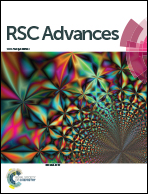AgPd nanoparticles supported on zeolitic imidazolate framework derived N-doped porous carbon as an efficient catalyst for formic acid dehydrogenation†
Abstract
Formic acid (FA) has tremendous potential as a safe and convenient source of hydrogen for renewable energy storage, but controlled and efficient dehydrogenation of FA by a robust solid catalyst constitutes a major challenge. In this report, a metal nanoparticle functionalized zeolitic imidazolate framework (ZIF) derived N-decorated nanoporous carbon (NPC) support was fabricated and used as an efficient FA decomposition catalyst for the first time. The resultant AgPd@NPC catalyst exhibited 100% H2 selectivity and high catalytic activity (TOF = 936 h−1) toward the dehydrogenation of formic acid at 353 K. The synergetic interaction between the metal nanoparticles and NPC greatly enhances the catalytic performance of the as-prepared catalyst.


 Please wait while we load your content...
Please wait while we load your content...